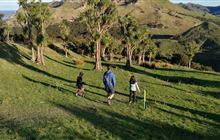Te Maire Loop Track
Located in Whanganui National Park in the Manawatu/Whanganui region
|
Introduction
Walk through a fine example of the podocarp forest that once covered much of the central North Island. It's a suitable track for kids.Dog access
Image gallery
The loop track takes around 2 hours and covers only a small part of the 420 ha reserve. This walk is suitable for people of all ages and has a stream crossing near the start of the track.
Te Maire Stream flows through the reserve and is usually low enough to cross without getting your feet wet, but can rise rapidly with heavy rain. Take care and check the weather conditions.
The track leads through stream terraces then slowly climbs through majestic old forest onto a ridgeline where it gently loops back to the stream crossing.
There is a toilet near the start of the track. Sturdy walking shoes are recommended
Keep your eyes and ears open for all the common forest birds;
- tūī
- kārearea/falcon
- korimako/bellbird, and
- toutouwau/robin.
From Taumarunui, take State Highway 43 from the north side of the Ongarue River Bridge. The Te Maire Bridge over the Whanganui River is 12 km south of Taumarunui Hospital. Across the bridge follow Paparoa Road to Te Maire Valley Road, signposted "Whanganui National Park, Te Maire". The entrance to the track is located around 700 m along this road.
Track safety information
- Stream crossing – Do not attempt to cross the stream in high water flow or during rain as water levels may raise rapidly. Be prepared to turn back or wait for conditions to improve.
- Weather conditions – track users are urged to observe the weather conditions and seek advice as wet, slippery conditions may be experienced at times, particularly during winter and early spring.
Additional safety information:
- Fires – fires are not permitted in Whanganui National Park.
- Communications – this area is remote with no cell phone coverage. It is recommended that you carry an emergency alert device (e.g. PLB/Spot tracker).
- Dropoffs – there are multiple dropoffs on this track. Care should be taken while passing these.
- Windfalls – there may be windfalls on the track after weather events. Care should be taken while going around the fallen trees.
- Water – during hot dry periods, extra water should be carried. Treat or boil all water before drinking.
- Wasps – wasps are a known hazard and are particularly common from January until May. Carry antihistamine if you are allergic to their stings.
Trip intentions
Te Maire Reserve is a fine example of the podocarp forest that once covered most of the Central North Island. Te Maire sits within the Whanganui National park which protects one of the largest remaining stretches of this forest type in New Zealand.
It is home to a mosaic of native trees including rimu, miro, totara, kahikatea, matai, rewarewa, hinau and tawa. It is also home to the rare subterranean plant Thismia rodwayi which due to the fact that it can only be found when flowering is rarely seen.
There is a vast array of native birds in the reserve including robins, kereru, grey warbler, shining cuckoo and long tailed cuckoo. There are several varieties of skinks and geckoes and an abundance of invertebrates and freshwater insects. In the Te Maire stream there is tuna, bully and koura, in recent times there have been lamprey, kokopu and black flounder.
Threats to nature
DOC as part of its management of Te Maire undertakes regular pest control. The forest suffers from the destructive effects of pests with goats browsing the forest floor and possums eating the forest canopy.
Goats and possums have a major impact on the vegetation and DOC manages these numbers through various methods of hunting and laying bait stations. Stoats, ferrets, rats, mice, feral cats, hedgehogs and magpies also threaten native wildlife in the reserve.
Contacts
| Whanganui Office | |
| Phone: | 0800 275 362 |
| Fax: | +64 4 471 1117 |
| Email: | whanganui@doc.govt.nz |
| Address: |
34-36 Taupo Quay Whanganui 4500 |
| Postal Address: |
Private Bag 3016 Whanganui 4540 |
| Full office details | |


